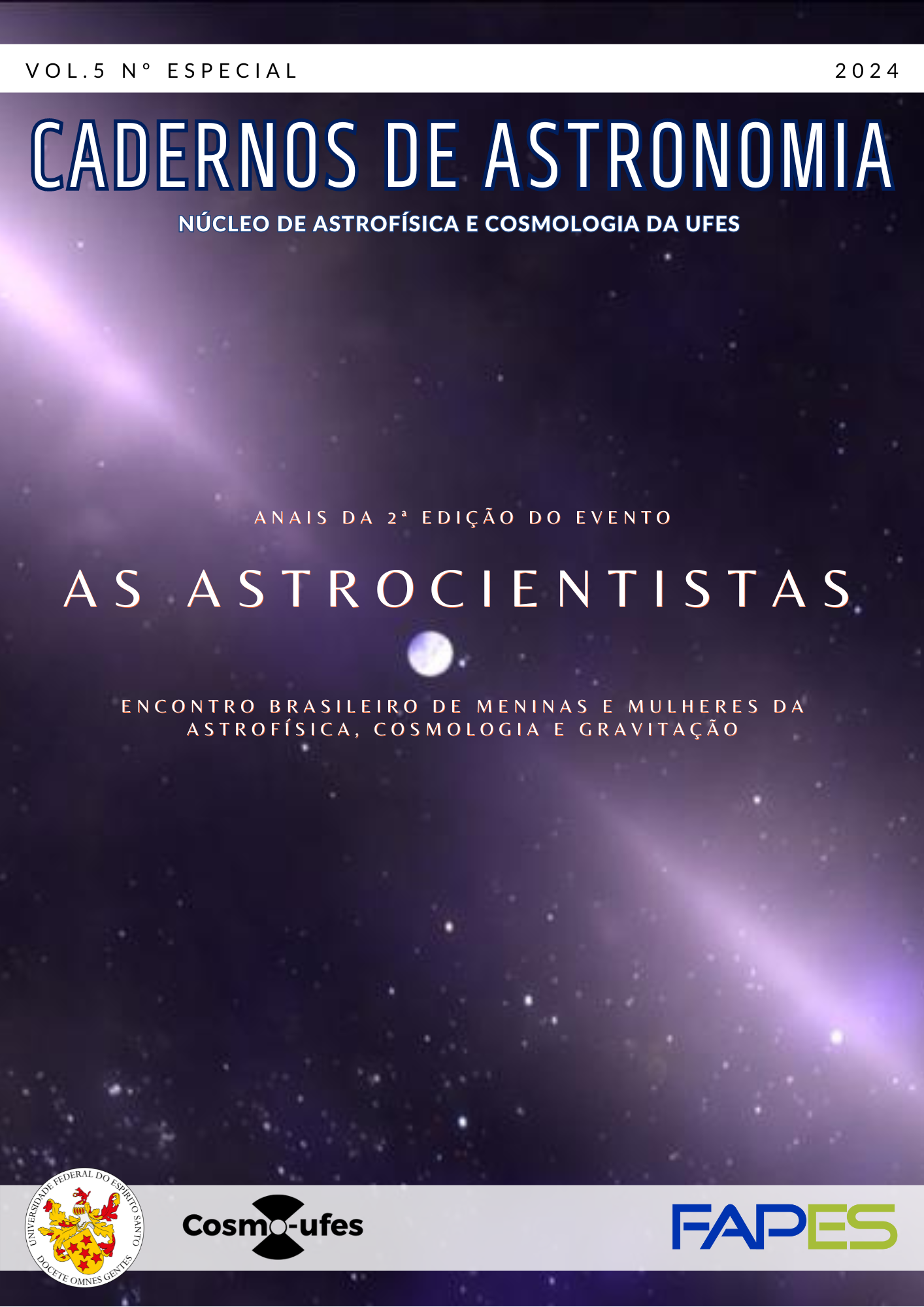Incertezas teóricas em testes do Princípio Cosmológico
DOI :
https://doi.org/10.47456/Cad.Astro.v5nEspecial.44955Mots-clés :
Cosmologia, quasares, velocidade peculiarRésumé
Estudos recentes encontraram discrepâncias na nossa velocidade peculiar, derivada do nosso movimento em relação à radiação cósmica de fundo (RCF) e à distribuição da matéria em grandes escalas. Isso desafia o Princípio Cosmológico, um conceito fundamental que sugere que a nossa velocidade deve permanecer consistente tanto na RCF como nos referenciais da matéria. Este trabalho explora a função de luminosidade (FL) dos quasares, que descreve como esses objetos estão distribuídos em termos de distância e brilho. Discutirei como diferentes modelos para a FL dos quasares impactam nas estimativas teóricas do dipolo cinemático e como ignorar a mudança no brilho do quasar ao longo do tempo pode levar a resultados diferentes para nossa velocidade peculiar.
Références
A. H. Guth, The Inflationary Universe: The quest for a new theory of cosmic ori gins (Addison-Wesley, Reading, Massachusetts, 1997), 1 ed.
M. Planck, Sobre a lei de distribuição de energia no espectro normal, Revista Brasileira de Ensino de Física 22(4), 538 (2000). Disponível em https://www.sbfisica.org.br/rbef/pdf/v22_538.pdf, acesso em jul. 2024.
J. Chluba et al., New horizons in cosmology with spectral distortions of the cosmic microwave background, Experimental Astronomy 51(3), 1515 (2021).
O. A. R. Garcia, Aberration and Doppler on the Cosmic Microwave Background: Kinematical and Intrinsic Effects, Tese de Doutorado, Universidade Federal do Rio de Janeiro (2016). Disponível em https://pos.if.ufrj.br/w p-content/uploads/2021/08/Omar-Rolda n-Garcia.pdf, acesso em jun. 2024.
C. Guandalin et al., Theoretical systematics in testing the Cosmological Principle with the kinematic quasar dipole, The Astrophysical Journal 953(2), 144 (2023).
N. Aghanim et al., Planck 2018 results-I. Over view and the cosmological legacy of Planck, Astronomy & Astrophysics 641, A1 (2020).
P. Peebles e D. T. Wilkinson, Comment on the anisotropy of the primeval fireball, Physical Review 174(5), 2168 (1968).
G. Ellis e J. Baldwin, On the expected anisotropy of radio source counts, Monthly Notices of the Royal Astronomical Society 206(2), 377 (1984).
C. Blake e J. Wall, Detection of the velocity dipole in the radio galaxies of the NRAO VLA sky survey (2002). ArXiv:0203385.
C. Gibelyou e D. Huterer, Dipoles in the sky, Monthly Notices of the Royal Astronomical Society 427(3), 1994 (2012).
M. Rubart e D. J. Schwarz, Cosmic radio di pole from NVSS and WENSS, Astronomy & Astrophysics 555, A117 (2013).
P. Tiwari et al., Dipole anisotropy in sky brightness and source count distribution in radio NVSS data, Astroparticle Physics 61, 1 (2015).
S. Ghosh et al., Probing statistical isotropy of cosmological radio sources using Square Kilo metre Array, Journal of Astrophysics and Astronomy 37(4), 1 (2016).
J. Colin et al., High-redshift radio galaxies and divergence from the CMB dipole, Monthly Notices of the Royal Astronomical Society 471(1), 1045 (2017).
C. A. Bengaly, R. Maartens e M. G. San tos, Probing the Cosmological Principle in the counts of radio galaxies at different frequencies, Journal of Cosmology and Astroparticle Physics 2018(04), 031 (2018).
N. J. Secrest et al., A test of the cosmological principle with quasars, The Astrophysical journal letters 908(2), L51 (2021).
N. J. Secrest et al., A challenge to the standard cosmological model, The Astrophysical journal letters 937(2), L31 (2022).
R. Maartens, C. Clarkson e S. Chen, The kinematic dipole in galaxy redshift surveys, Journal of Cosmology and Astroparticle Physics 2018(01), 013 (2018).
C. Dalang e C. Bonvin, On the kinematic cosmic dipole tension, Monthly Notices of the Royal Astronomical Society 512(3), 3895 (2022).
M. S. Wang, F. Beutler e D. Bacon, Impact of relativistic effects on the primordial non Gaussianity signature in the large-scale clustering of quasars, Monthly Notices of the Royal Astronomical Society 499(2), 2598 (2020).
N. Sabti, J. B. Muñoz e D. Blas, New roads to the small-scale Universe: measurements of the clustering of matter with the high-redshift UV galaxy luminosity function, The Astrophysical Journal Letters 928(2), L20 (2022).
C. Q. A. Silva, Identificação e redshifts foto métricos para quasares do tipo-I com sistemas de filtros de bandas médias e estreitas, Dissertação de Mestrado, Universidade de São Paulo (2015). Disponível em https://www.teses.usp.br/teses/disponiveis/43/43134/tde-06012016-185554/pt-br.php, acesso em jul. 2024.
R. Johnston, Shedding light on the galaxy luminosity function, The Astronomy and Astrophysics Review 19(1) (2011).
C. Q. d. A. Silva, Redshifts fotométricos de quasares em levantamentos de bandas estreitas, Tese de Doutorado, Universidade de São Paulo (2021). Disponível em https://www.teses.usp.br/teses/disponiveis/43/43134/tde-05032021-172936/pt-br.php, acesso em jul. 2024.
B. J. Boyle et al., The 2dF QSO Redshift Survey—I. The optical luminosity function of quasi-stellar objects, Monthly Notices of the Royal Astronomical Society 317(4), 1014 (2000).
S. M. Croom et al., The 2dF QSO Redshift Survey–XII. The spectroscopic catalogue and luminosity function, Monthly Notices of the Royal Astronomical Society 349(4), 1397 (2004).
S. M. Croom et al., The 2dF–SDSS LRG and QSO survey: the QSO luminosity function at 0.4 < z < 2.6, Monthly Notices of the Royal Astronomical Society 399(4), 1755 (2009).
N. P. Ross et al., The SDSS-III baryon oscillation spectroscopic survey: the quasar luminosity function from data release nine, The Astrophysical Journal 773(1), 14 (2013).
N. Palanque-Delabrouille et al., The extended Baryon Oscillation Spectroscopic Survey: Variability selection and quasar luminosity function, Astronomy & Astrophysics 587, A41 (2016).
L. Pozzetti et al., Modelling the number density of Hα emitters for future spectroscopic near IR space missions, Astronomy & Astrophysics 590, A3 (2016).
D. Foreman-Mackey et al., emcee: The MCMC Hammer, PASP 125, 306 (2013). ArXiv:1202 .3665.
S. von Hausegger, The expected kinematic mat ter dipole is robust against source evolution (2024). ArXiv:2404.07929.
D. Blas, J. Lesgourgues e T. Tram, The Cos mic Linear Anisotropy Solving System (CLASS). Part II: Approximation schemes, Journal of Cosmology and Astroparticle Physics 2011(07), 034 (2011).
C. R. Harris et al., Array programming with NumPy, Nature 585(7825), 357 (2020).
P. Virtanen et al., SciPy 1.0: Fundamental Algorithms for Scientific Computing in Python, Nature Methods 17, 261 (2020).
J. D. Hunter, Matplotlib: A 2D graphics environment, Computing in Science & Engineering 9(3), 90 (2007).
Téléchargements
Publiée
Numéro
Rubrique
Licence
(c) Copyright Caroline Guandalin 2024

Ce travail est disponible sous la licence Creative Commons Attribution 4.0 International .






